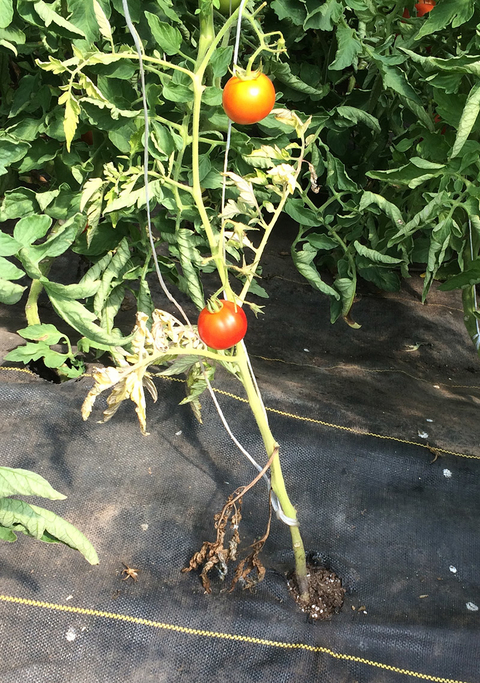Quick facts
- Fusarium crown and root rot may result in stunted seedlings, rotting roots, stem discoloration, wilting and death.
- Hosts include tomato, pepper, eggplant, and a number of common weeds.
- The fungus can spread by root-to-root contact, the air, or surfaces such as equipment, other plants, and workers.
- There are some tomato varieties with resistance to Fusarium crown and root rot. Various cultural control methods are recommended.
- The fungus Fusarium oxysporum f. sp. radicis-lycopersici (FORL) causes this disease in tomato, pepper, eggplant, and a number of common weeds.
Telling fusarium crown and root rot from other tomato issues
- Stunted, yellowed seedlings.
- Lower leaves turn yellow and drop prematurely. Plant wilts and may die.
- Chocolate brown lesion girdles the main stem just above the soil line. Roots are rotted, discolored, and stunted. There may be an abnormal amount of adventitious roots above this lesion.
- Reddish to brown discoloration of the stem when sliced lengthwise.
Fusarium crown and root rot can look very different in different varieties, submit a sample to the U of M Plant Disease Clinic for diagnosis.
Biology
- The fungus Fusarium oxysporum f. sp. radicis-lycopersici is the cause of fusarium crown and root rot.
- Fungus thrives in cool temperatures (50 to 70°F optimum), low pH soil, and areas of poor drainage that are prone to becoming waterlogged.
- Fusarium spores are produced on stem lesions and can spread through the air and infect above-ground plant parts.
- The fungus can spread by root-to-root contact, resulting in clusters of diseased plants. It can also spread through the movement of soil and roots on equipment, plants, and workers.
- The fungus survives as thick-walled spores (Chlamydospores) in soil, wooden stakes, and on other high tunnel surfaces.
Managing fusarium crown and root rot in the home garden
Resistant varieties
There are some tomato varieties with resistance to fusarium crown and root rot. Look for the code FOR on seed packets, plant tags and catalogs to find resistant varieties.
Cultural controls
- Practice rotation by crop family.
- Maintain a soil pH of 6 to 7, as the fungus thrives in low pH soil.
- Avoid wounding young transplants during planting.
- Remove plant debris when done with harvest.
- Promptly bag and remove infected plants, including roots to prevent spread. Remove and replace any stakes that touched infected plants.
Managing fusarium crown and root rot on farms
Resistant varieties
- There are some tomato varieties with resistance to fusarium crown and root rot.
- A list of resistant tomato varieties can be found on the Cornell University Vegetable website.
- In addition, susceptible varieties can be protected by grafting onto resistant varieties.
Cultural control
- Maintain a soil pH of 6 to 7.
- Promptly bag and remove infected plants, including roots to prevent spread.
- Remove or plow in remaining plant debris immediately after harvest to encourage decomposition.
- Reduce transmission year-to-year by using new stakes or new strings each year.
- Avoid wounding young transplants during planting.
- Disinfect boots by washing them between high tunnels, or keep separate tools and boots for high tunnels. Begin working in the cleanest tunnels first.
Using fungicides
There are no fungicides that are effective for managing Fusarium crown and root rot.
Reviewed in 2021




